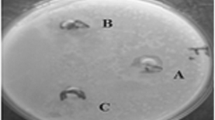Abstract
The objective of this paper was to design a chewing gum formulation delivery system in situations where typical dental hygiene practice is not practical. Thus, an analog of decapeptide KSL (KSL-W), known to possess antimicrobial and antiplaque activity, was incorporated into a chewing gum formulation containing cetylpyridinium chloride (CPC). The effect of the excipients, xylitol, and peppermint oil on active ingredients in vitro release was also assessed. Gum formulations were prepared with different excipient parameters, including heating xylitol and gum base at 65 or 85°C, using ground and unground xylitol, and the addition of 1.5, 3, and 7% peppermint oil, to determine the effect of these changes on the in vitro release of KSL-W and CPC using a chewing machine. The antimicrobial and antiplaque activities of solutions released from chewed gum formulation as well as prepared standard solutions with different concentrations were tested against placebo. The optimal temperature to avoid crystallization of xylitol during preparation was 65°C. Grinding xylitol to 104.5 μm improved release of active ingredients as compared to commercially unground xylitol. Peppermint oil had opposite effects on release of KSL-W and CPC. Peppermint oil at 1.5% was determined to be suitable (91 and 88% of KSL-W and CPC released, respectively, after 40 min). The gum formulation illustrated good sustained release of KSL-W and CPC with antibacterial and antiplaque activities after chewing. An effective antimicrobial and antiplaque chewing gum formulation was developed. This formulation has the potential to overcome oral hygiene issues in those unable to follow normal dental protocols.






Similar content being viewed by others
References
Wade WG. The oral microbiome in health and disease. Pharmacol Res. 2013;69(1):137–43.
Nakano K, Nemoto H, Nomura R, Inaba H, Yoshioka H, Taniguchi K, et al. Detection of oral bacteria in cardiovascular specimens. Oral Microbiol Immunol. 2009;24(1):64–8.
Takahashi K, Fukazawa M, Motohira H, Ochiai K, Nishikawa H, Miyata T. A pilot study on antiplaque effects of mastic chewing gum in the oral cavity. J Periodontol. 2003;74(4):501–5.
Tellefsen G, Larsen G, Kaligithi R, Zimmerman GJ, Wikesjo UME. Use of chlorhexidine chewing gum significantly reduces dental plaque formation compared to use of similar xylitol and sorbitol products. J. Periodontol. 1996;67(3):181–3.
Giuliani A, Pirri G, Nicoletto SF. Antimicrobial peptides: an overview of a promising class of therapeutics. Cent Eur J Biol. 2007;2(1):1–33.
Na DH, Faraj J, Capan Y, Leung KP, DeLuca PP. Stability of antimicrobial decapeptide (KSL) and its analogues for delivery in the oral cavity. Pharm Res. 2007;24(8):1544–50.
Na DH, Faraj J, Capan Y, Leung KP, DeLuca PP. Chewing gum of antimicrobial decapeptide (KSL) as a sustained antiplaque agent: Preformulation study. J Control Release. 2005;107(1):122–30.
Faraj JA, Dorati R, Schoubben A, Worthen D, Selmin F, Capan Y, et al. Development of a peptide-containing chewing gum as a sustained release antiplaque antimicrobial delivery system. AAPS PharmSciTech. 2007;8(1):E1–9.
Quisno R, Foter MJ. Cetyl pyridium chloride.1. Germicidal properties. J Bacteriol. 1946;52(1):111–7.
Beiswanger BB, Boneta AE, Mau MS, Katz BP, Proskin HM, Stookey GK. The effect of chewing sugar-free gum after meals on clinical caries incidence. J Am Dent Assoc. 1998;129:1623–6.
Edgar WM. Sugar substitutes, chewing gum and dental caries. Br Dent J. 1998;184:29–32.
Machiulskiene V, Nyvad B, Baelum V. Caries preventive effect of sugar-substituted chewing gum. Community Dent Oral Epidemiol. 2001;29:278–88.
Kandelman D, Gagnon G. A 24-month clinical study of the incidence and progression of dental caries in relation to consumption of chewing gum containing xylitol in school preventive programs. J Dent Res. 1990;69:1771–5.
Hayes C. The effect of non-cariogenic sweeteners on the prevention of dental caries: A review of the evidence. J Dent Educ. 2001;65:1106–9.
Carpentier L, Desprez S, Descamps M. Crystallization and glass properties of pentitols - Xylitol, adonitol, arabitols. J Therm Anal Calorim. 2003;73(2):577–86.
Concannon SP, Crowe TD, Abercrombie JJ, Molina CM, Hou P, Sukumaran DK, et al. Susceptibility of oral bacteria to an antimicrobial decapeptide. J Med Microbiol. 2003;52(12):1083–93.
Tanzer M. Xylitol chewing gum and dental caries. Int Dent J. 1995;45-1:65–76.
Soderling E. Influence of maternal xylitol consumption on mother-child transmission of mutans streptococci: 6-year follow-up. C. Res. 2001;35:173–7.
Leung K, Abercrombie J, Campbell T, Gilmore K, Bell C, Faraj J, DeLuca P. Antimicrobial Peptides for Plaque Control. Adv Dent Res. 2009;21:57–62.
Marsh P. Microbiologic aspects of dental plaque and dental caries. Dent Clin North Am. 1999;43:599–614.
Listgarten M. The structure of dental plaque. Periodontol 2000. 1994;5:52–65.
Hildebrandt GH, Sparks BS. Maintaining mutans streptococci suppression with xylitol chewing gum. J Am Dent Assoc. 2000;131:909–16.
Ly K, Milgrom P, Rothen M. Xylitol, sweeteners, and dental caries. Pediatr Dent. 2006;28:154–63.
Acknowledgements
This work was supported by a research grant from US Army Medical Research and Materiel Command. KPL is an employee of the US Government. The views expressed in this article are those of the authors and do not reflect the official policy or position of the Department of the Army, the Department of Defense or the US Government.
Author information
Authors and Affiliations
Corresponding author
Rights and permissions
About this article
Cite this article
Al-Ghananeem, A.M., Leung, K.P., Faraj, J. et al. Development of a Sustained Antiplaque and Antimicrobial Chewing Gum of a Decapeptide. AAPS PharmSciTech 18, 2240–2247 (2017). https://doi.org/10.1208/s12249-016-0706-9
Received:
Accepted:
Published:
Issue Date:
DOI: https://doi.org/10.1208/s12249-016-0706-9




